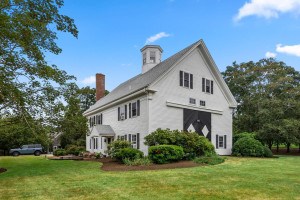Why the Sale of Blackstone Office Buildings Could Mean Higher Rents

60 State Street photo via Shutterstock
In an transaction worth an estimated $2.1 billion, The Blackstone Group is selling four of the buildings in its Boston office portfolio, including properties at 225 Franklin, 60 State Street, 100 High Street, 125 Summer Street, as well as One Memorial in Cambridge, according to the New York Times. In addition, the company is selling its share in the Rowes Wharf mixed-use project.
The corporate real estate industry might not be of much interest to the general population, but it matters in an indirect way. When an office building changes hands, it often means the new owner will invest in interior and mechanical upgrades, which means that office workers might have to suffer through a bit of construction. The end result is a nicer building, though, so it’s often worth it. Building owners will often do this neatening up prior to putting their properties up for sale, as well … so if you hear a lot of workers banging around your office, keep an eye out for bankers in the hallways.
It can often mean that the office tenants will be hit with a rent increase as the new owner looks for a way to make back its investment. This happens a lot when there’s a tight real estate market, which is often stated as a vacancy rate percentage. A vacancy rate under 10 percent is considered a “landlord’s market.” If the landlord raises a company’s rent, the company may look for somewhere else to “live,” just like you do when your apartment rent increases. So, as a result, this brings lots of change for where companies are located. (Hello, Route 128!) Fortunately for them, many larger companies have long-term leases so their rents can remain stable for years.
Boston has about 60-million square feet of office space spread across three major sub-markets: Downtown, Back Bay, and Seaport District, and each has its strengths and weaknesses. The biggest is the Downtown market, with about 35-million square feet of space. Downtown is the most-popular commercial district in the City, although it has recently lost its luster.
The Back Bay is the hottest sub-market right now and Boston Properties is the biggest player. Among its major holdings are both the Hancock Tower and the Prudential Center. In all, it controls more than 13.6 million square feet of space in Boston. It’s because of their size that they are so important; they control the Back Bay office sub-market—meaning they control the rents. That’s a lot of power in a city where a very restrictive zoning policy means very little can be built.
The Seaport District is being bandied about as “the next new thing,” and rents are rising to reflect this, but mostly, the area is still one big parking lot, with little actual supply. (It’s about one-fifth the size as the Downtown sub-market.) It’s yet to be determined if its desirability will develop as strongly as expected.
There was a time when Boston’s corporations were both landlord and tenant. New England Merchants Bank built 28 State Street, The Boston Company built One Boston Place, and the First National Bank of Boston built “the Pregnant Building” at 100 Federal. Over the years, however, they’ve been sold (and resold). Nowadays, many developers from the very beginning have the intention to build and sell. Joe Fallon built a pair of 15-story office towers on Fan Pier for a client list that included Vertex Pharmaceuticals but sold it off as soon as it was completed for $1.125 billion, quite a nice gain on his $800-million investment.
People pay lots of attention to how the housing market in Boston is doing, but the deals in the commercial real estate sector give hints about the overall health of the city. Right now, there is a lot of re-sale activity as investors re-position themselves to take advantage of the strengthening local and national economy.
Eventually, investors will run out of existing properties to buy and sell and begin considering building anew. That’s when things will get really exciting.


